Page 426 of 543
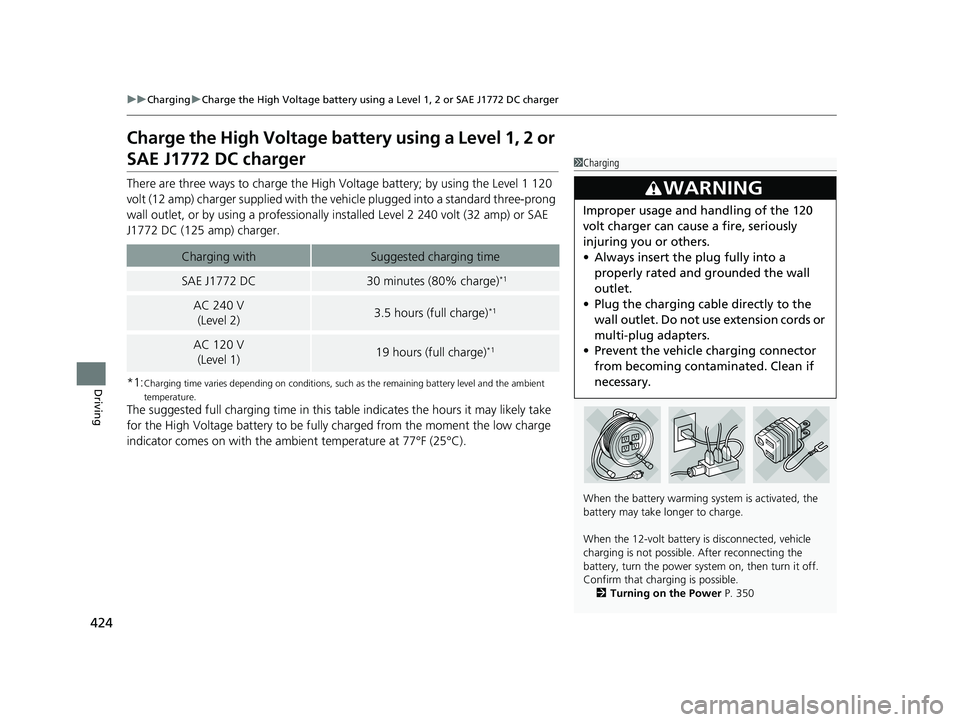
424
uuCharging uCharge the High Voltage battery using a Level 1, 2 or SAE J1772 DC charger
Driving
Charge the High Voltage battery using a Level 1, 2 or
SAE J1772 DC charger
There are three ways to charge the High Voltage battery; by using the Level 1 120
volt (12 amp) charger supplied with the vehicle plugged into a standard three-prong
wall outlet, or by using a professionally installed Level 2 240 volt (32 amp) or SAE
J1772 DC (125 amp) charger.
*1:
Charging time varies depending on conditions, such as the remaining battery level and the ambient
temperature.
The suggested full charging time in this table indicates the hours it may likely take
for the High Voltage battery to be fully charged from the moment the low charge
indicator comes on with the ambient temperature at 77°F (25°C).
Charging withSuggested charging time
SAE J1772 DC 30 minutes (80% charge)*1
AC 240 V (Level 2)3.5 hours (full charge)*1
AC 120 V
(Level 1)19 hours (full charge)*1
1 Charging
When the battery warming system is activated, the
battery may take longer to charge.
When the 12-volt battery is disconnected, vehicle
charging is not possible. After reconnecting the
battery, turn the power system on, then turn it off.
Confirm that charging is possible. 2 Turning on the Power P. 350
3WARNING
Improper usage and handling of the 120
volt charger can cause a fire, seriously
injuring you or others.
•Always insert the plug fully into a
properly rated and grounded the wall
outlet.
• Plug the charging cable directly to the
wall outlet. Do not use extension cords or
multi-plug adapters.
• Prevent the vehicle charging connector
from becoming contaminated. Clean if
necessary.
17 CLARITY BEV CSS-31TRV6000.book 424 ページ 2017年4月14日 金曜日 午前11 時8分
Page 427 of 543
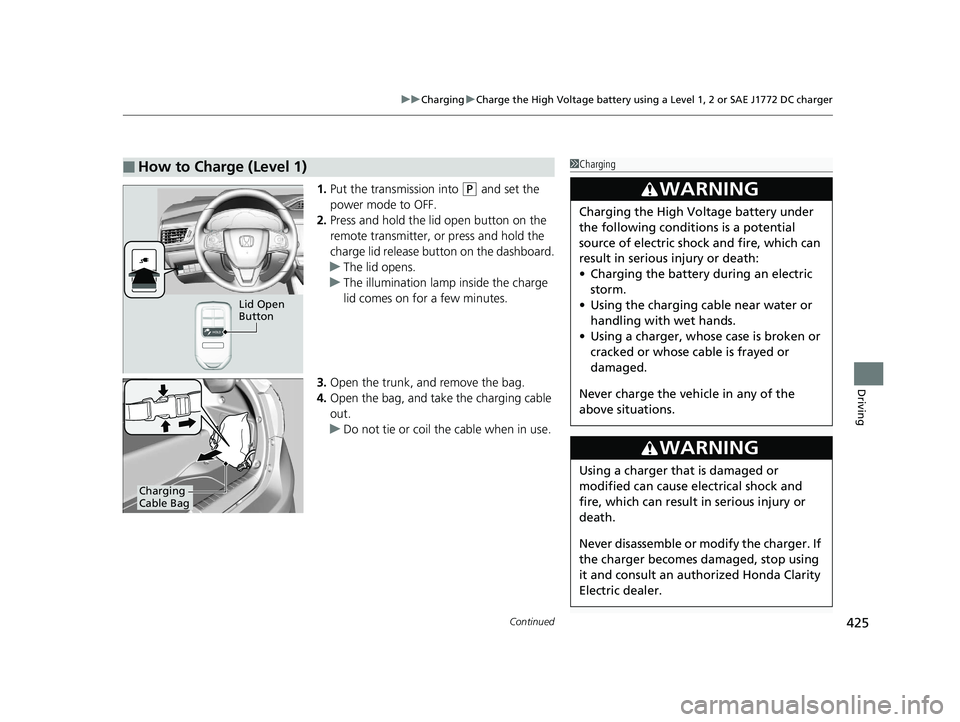
Continued425
uuCharging uCharge the High Voltage battery using a Level 1, 2 or SAE J1772 DC charger
Driving
1. Put the transmission into (P and set the
power mode to OFF.
2. Press and hold the lid open button on the
remote transmitter, or press and hold the
charge lid release button on the dashboard.
u The lid opens.
u The illumination lamp inside the charge
lid comes on for a few minutes.
3. Open the trunk, and remove the bag.
4. Open the bag, and take the charging cable
out.
u Do not tie or coil the cable when in use.
■How to Charge (Level 1)
Lid Open
Button
Charging
Cable Bag
1Charging
3WARNING
Charging the High Vo ltage battery under
the following conditions is a potential
source of electric shock and fire, which can
result in serious injury or death:
• Charging the battery during an electric
storm.
• Using the charging cable near water or
handling with wet hands.
• Using a charger, whose case is broken or
cracked or whose cable is frayed or
damaged.
Never charge the vehi cle in any of the
above situations.
3WARNING
Using a charger that is damaged or
modified can cause electrical shock and
fire, which can result in serious injury or
death.
Never disassemble or modify the charger. If
the charger becomes damaged, stop using
it and consult an authorized Honda Clarity
Electric dealer.
17 CLARITY BEV CSS-31TRV6000.book 425 ページ 2017年4月14日 金曜日 午前11 時8分
Page 428 of 543
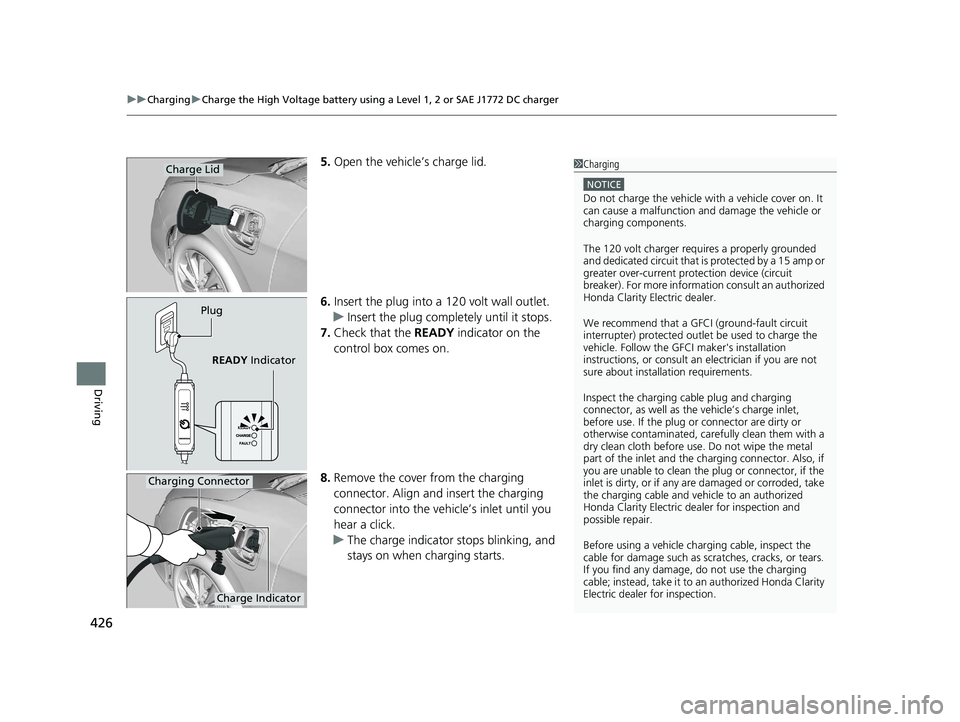
uuCharging uCharge the High Voltage battery using a Level 1, 2 or SAE J1772 DC charger
426
Driving
5. Open the vehicle’s charge lid.
6. Insert the plug into a 12 0 volt wall outlet.
u Insert the plug completely until it stops.
7. Check that the READY indicator on the
control box comes on.
8. Remove the cover from the charging
connector. Align and insert the charging
connector into the vehi cle’s inlet until you
hear a click.
u The charge indicator stops blinking, and
stays on when charging starts.Charge Lid
Plug
READY Indicator
1Charging
NOTICE
Do not charge the vehicle wi th a vehicle cover on. It
can cause a malfunction and damage the vehicle or
charging components.
The 120 volt charger requires a properly grounded
and dedicated circuit that is protected by a 15 amp or
greater over-curre nt protection device (circuit
breaker). For more information consult an authorized
Honda Clarity Electric dealer.
We recommend that a GFCI (ground-fault circuit
interrupter) protected outlet be used to charge the
vehicle. Follow the GF CI maker's installation
instructions, or consult an electrician if you are not
sure about installation requirements.
Inspect the charging cable plug and charging
connector, as well as the vehicle’s charge inlet,
before use. If the plug or connector are dirty or
otherwise contaminated, care fully clean them with a
dry clean cloth before use. Do not wipe the metal
part of the inlet and the ch arging connector. Also, if
you are unable to clean the plug or connector, if the
inlet is dirty, or if any ar e damaged or corroded, take
the charging cable and vehi cle to an authorized
Honda Clarity Electric de aler for inspection and
possible repair.
Before using a vehicle char ging cable, inspect the
cable for damage such as scratches, cracks, or tears.
If you find any damage, do not use the charging
cable; instead, take it to an authorized Honda Clarity
Electric dealer for inspection.
Charging Connector
Charge Indicator
17 CLARITY BEV CSS-31TRV6000.book 426 ページ 2017年4月14日 金曜日 午前11 時8分
Page 429 of 543
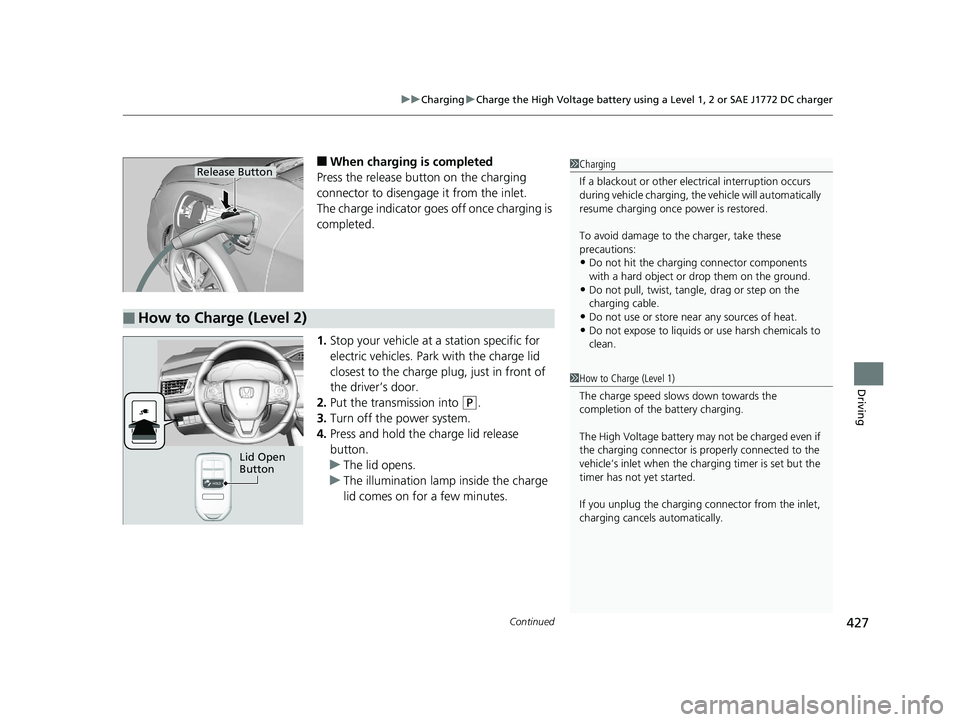
Continued427
uuCharging uCharge the High Voltage battery using a Level 1, 2 or SAE J1772 DC charger
Driving
■When charging is completed
Press the release button on the charging
connector to disengag e it from the inlet.
The charge indicator goes off once charging is
completed.
1. Stop your vehicle at a station specific for
electric vehicles. Park with the charge lid
closest to the charge plug, just in front of
the driver’s door.
2. Put the transmission into
(P.
3. Turn off the power system.
4. Press and hold the charge lid release
button.
u The lid opens.
u The illumination lamp inside the charge
lid comes on for a few minutes.
1Charging
If a blackout or other elec trical interruption occurs
during vehicle charging, the vehicle will automatically
resume charging once power is restored.
To avoid damage to th e charger, take these
precautions:
•Do not hit the charging connector components
with a hard object or drop them on the ground.
•Do not pull, twist, tangle, drag or step on the
charging cable.
•Do not use or store near any sources of heat.
•Do not expose to liquids or use harsh chemicals to
clean.
Release Button
■How to Charge (Level 2)
1How to Charge (Level 1)
The charge speed slows down towards the
completion of the battery charging.
The High Voltage battery may not be charged even if
the charging connector is properly connected to the
vehicle’s inlet when the charging timer is set but the
timer has not yet started.
If you unplug the charging connector from the inlet,
charging cancels automatically.
Lid Open
Button
17 CLARITY BEV CSS-31TRV6000.book 427 ページ 2017年4月14日 金曜日 午前11 時8分
Page 430 of 543
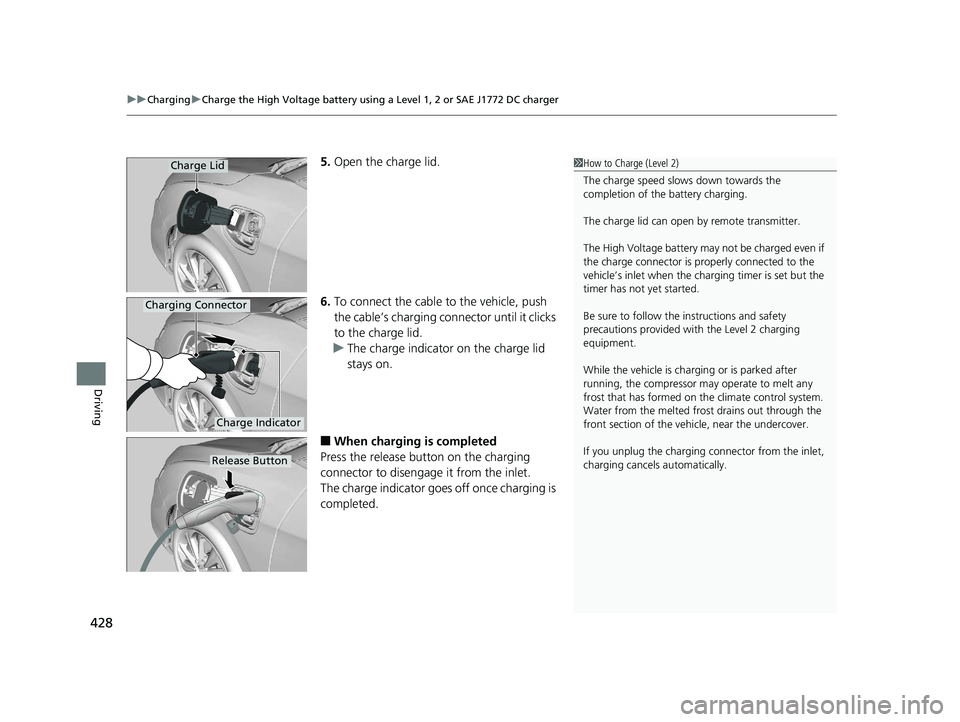
uuCharging uCharge the High Voltage battery using a Level 1, 2 or SAE J1772 DC charger
428
Driving
5. Open the charge lid.
6. To connect the cable to the vehicle, push
the cable’s charging conn ector until it clicks
to the charge lid.
u The charge indicator on the charge lid
stays on.
■When charging is completed
Press the release button on the charging
connector to disengage it from the inlet.
The charge indicator goes off once charging is
completed.
1 How to Charge (Level 2)
The charge speed slows down towards the
completion of the battery charging.
The charge lid can open by remote transmitter.
The High Voltage battery may not be charged even if
the charge connector is properly connected to the
vehicle’s inlet when the charging timer is set but the
timer has not yet started.
Be sure to follow the instructions and safety
precautions provided with the Level 2 charging
equipment.
While the vehicle is charging or is parked after
running, the compressor may operate to melt any
frost that has formed on the climate control system.
Water from the melt ed frost drains out through the
front section of the vehi cle, near the undercover.
If you unplug the charging connector from the inlet,
charging cancels automatically.Charge Lid
Charge Indicator
Charging Connector
Release Button
17 CLARITY BEV CSS-31TRV6000.book 428 ページ 2017年4月14日 金曜日 午前11 時8分
Page 431 of 543
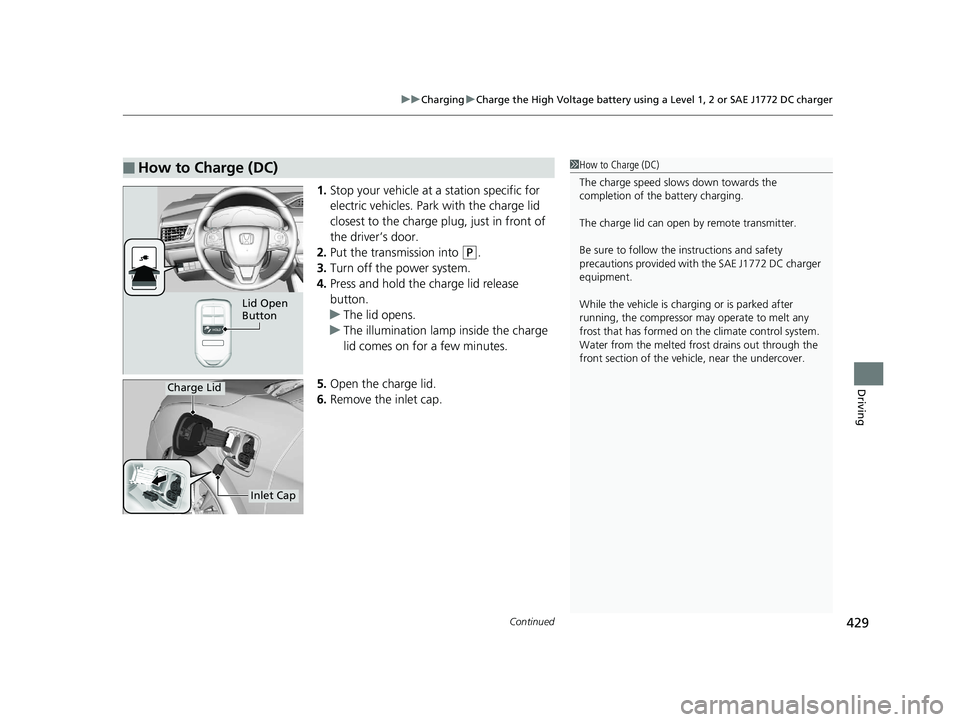
Continued429
uuCharging uCharge the High Voltage battery using a Level 1, 2 or SAE J1772 DC charger
Driving
1. Stop your vehicle at a station specific for
electric vehicles. Park with the charge lid
closest to the charge plug, just in front of
the driver’s door.
2. Put the transmission into
(P.
3. Turn off the power system.
4. Press and hold the charge lid release
button.
u The lid opens.
u The illumination lamp inside the charge
lid comes on for a few minutes.
5. Open the charge lid.
6. Remove the inlet cap.
■How to Charge (DC)1How to Charge (DC)
The charge speed slows down towards the
completion of the battery charging.
The charge lid can open by remote transmitter.
Be sure to follow the instructions and safety
precautions provided with the SAE J1772 DC charger
equipment.
While the vehicle is charging or is parked after
running, the compressor may operate to melt any
frost that has formed on the climate control system.
Water from the melt ed frost drains out through the
front section of the vehi cle, near the undercover.
Lid Open
Button
Charge Lid
Inlet Cap
17 CLARITY BEV CSS-31TRV6000.book 429 ページ 2017年4月14日 金曜日 午前11 時8分
Page 432 of 543
uuCharging uCharge the High Voltage battery using a Level 1, 2 or SAE J1772 DC charger
430
Driving
7. To connect the cable to the vehicle, push
the cable’s charging conn ector until it clicks
to the charge lid.
u The charge indicator on the charge lid
stays on.
■When charging is completed
Press the release button on the charging
connector to disengage it from the inlet. u Make sure to put the cover back on the
inlet before you close the lid.
The charge indicator goes off once charging is
completed.
1 How to Charge (DC)
If the charging connector does not disengage, do not
engage it forcefully, a nd follow the procedures
mentioned in the following page. 2 When You Cannot Disengage the Charging
Connector P. 517Charging Connector
Charge Indicator
Release Button
17 CLARITY BEV CSS-31TRV6000.book 430 ページ 2017年4月14日 金曜日 午前11 時8分
Page 433 of 543
431
uuCharging uControl Box
Continued
Driving
Control Box
READY Indicator
CHARGE Indicator
FAULT Indicator
Timer OnControl Box LED Status IndicatorCharge
IndicatorExplanatory notes Goes off Stays on BlinkingREADYCHARGEFAULT
InitializingInitial processing
Stand by SlowlyReady and waiting for the timer
ChangeComes on during charge.
CompletionCharge end
17 CLARITY BEV CSS-31TRV6000.book 431 ページ 2017年4月14日 金曜日 午前11 時8分